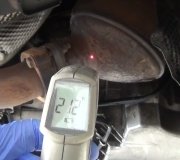If the timing belt jumps one tooth, the Check Engine light will be turned on by the Engine Computer and it will set a diagnostic fault code for "cam and crank sync". Engine power will be down at all speeds.
If the belt jumps two teeth, the computer will shut the engine down to protect it. It does that by turning off the automatic shutdown (ASD)" relay. That relay sends current to the ignition coil(s), injectors, alternator field, oxygen sensor heaters, and fuel pump or pump relay. At three teeth off or if the belt breaks, open valves will be hit and bent by the pistons as they coast to a stop. That's a real expensive repair that is easily avoided by having the timing belt replaced at scheduled intervals.
You didn't say which engine you have. On the single overhead cam engine, a sheared key between the camshaft and sprocket is common. Eventually the sprocket turns slightly on the cam. That causes late valve timing just as if the timing belt had jumped a tooth, and will be detected by the computer. The same code, "cam and crank sync" will be in memory but the timing belt will appear to be correct.
Tuesday, January 3rd, 2012 AT 11:34 PM


